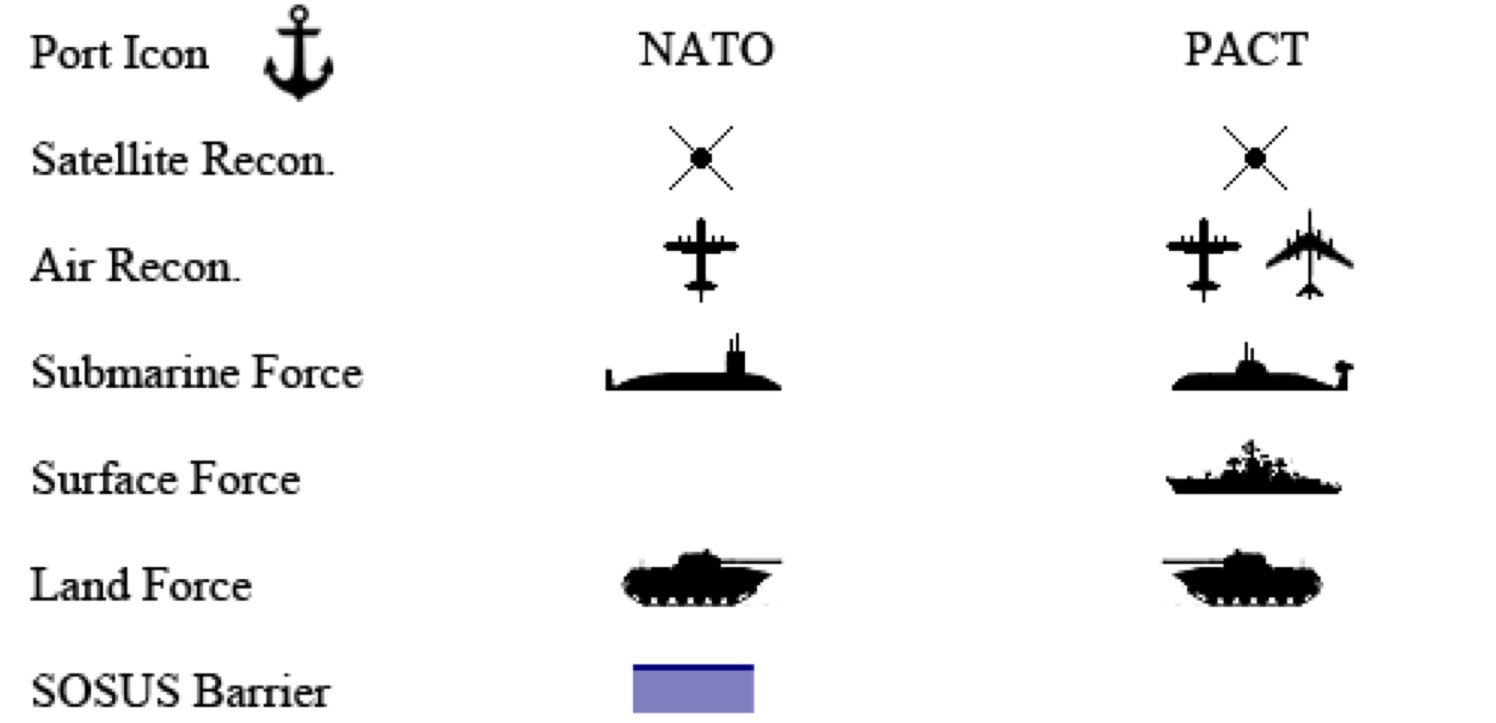Cold Waters Strategic Map Guide
The Strategic map is used to navigate the oceans and provides an overview of the theatre of war. The strategic map consists of a toolbar in the upper left, a sea chart of the theatre of operations along various icons. With the exception of the port and SOSUS barriers, icons are colored according to the side they fight for.
TOOLBAR
In the upper left is the toolbar. From left to right the toolbar displays:
1) Time of day in hours
2) Date
3) Labels button to toggle map text and locations on/off
4) Menu button to enter the Campaign Menu, or use Escape
5) Port icon indicating whether the player is in the vicinity of a friendly port
NAVIGATION
There are three movement speeds for your submarine on the Strategic Map.
1) Stationary: Your submarine is listening. Combat starts at ~5 knots and at shallow depth.
2) Patrol Speed: Combat starts at ~15 knots and at moderate depth. LEFT CLICK (Comma) to move at patrol speed toward the mouse pointer.
3) Full Speed: Combat starts at ~25 knots and at a deep depth. RIGHT-CLICK (Period) to move at full speed toward the mouse pointer.
When encountering an enemy force, the speed at which you are moving impacts starting distances, as sonar is less effective due to flow noise at faster speeds. Start depth may be altered by terrain if in shallow waters.
Your submarine’s speed also determines the range at which you reveal nearby enemy units. Faster speeds decrease the detection range.
RECONNAISSANCE
In the Cold War era, reconnaissance is performed by satellites, aircraft, task forces, and SOSUS barriers. Once encountered by your reconnaissance or directly by close proximity to your submarine, an enemy vessel or task force has been detected and will be revealed on the Strategic Map as an icon. The icon type, surface vessel or submarine, represents the type of enemy unit or units encountered. Mixed groups, containing submarines and surface units, default to the surface unit icon.
As the contact ages, it slowly darkens and its position stops being updated. These darker icons now show the last known location, becoming less accurate over time as the enemy moves on until the icon eventually disappears.
Satellites: both friendly and enemy satellites traverse the Strategic Map at regular intervals. Satellites have a very long detection range, but their passing is at regular intervals making it possible to time your positioning during a flyover by an enemy satellite.
Aircraft: launched from locations containing an airbase, aircraft patrol out from and then return to their base. Aircraft require some downtime to refuel between each patrol.
SOSUS Barriers: (Sound Surveillance System) are chains of sonar listening devices designed to reveal the passage of submarines and ships. Predominately used by NATO, these barriers are strategically placed to guard the choke points of passage from the Norwegian Sea into the Atlantic by Soviet forces. Enemy units crossing a SOSUS barrier are revealed on the Strategic Map.
Vessels: your own submarine (and enemy forces) can detect and reveal nearby units on the Strategic Map.
LOCATIONS
Across the Strategic Map are numerous locations. They may be naval ports, airbases, SOSUS stations, or a combination of these along with other strategic major cities and towns. Many of these locations may be directly involved in missions you are assigned and, if a campaign contains a ground war, these locations can be attacked by special forces (commandos) or even invaded and liberated by the opposing sides.
Naval Ports: these hubs of naval activity are usually the source of enemy forces and can be infiltrated and attacked by either side’s commandos. Your home port cannot be attacked or invaded by the enemy.
Airbases: as mentioned above, these are the source of reconnaissance aircraft. If an enemy commando group attacks an airbase, it disrupts aircraft reconnaissance activity for several days. If an amphibious landing or land-based invasion takes over a region containing an airbase, also it disrupts aircraft reconnaissance activity, but eventually restores it for the occupying side.
SOSUS Bases: If an enemy commando group attacks or the region is invaded, any SOSUS barrier associated with the location is lost permanently for the remainder of that campaign.
Regions may be invaded as part of the ongoing land war, but may also be invaded by amphibious landing forces you have been tasked with stopping! In the latter case, you have direct control over saving these valuable reconnaissance resources as well as preventing the enemy from opening new fronts.





